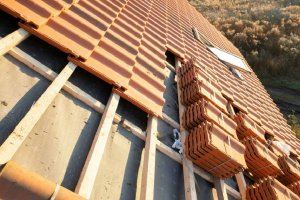Protecting your home’s exterior from harsh weather and other elements keeps your home’s aesthetic appeal sharp while also maintaining your property’s integrity. In this comprehensive guide, we’ll get into the details of 10 maintenance practices you shouldn’t skip. Plus, if you ever need expert help, Maupin Roofing has your back!
Why Maintain Your Outdoor Space and the Exterior of Your Home?

Aside from improving your home’s curb appeal, this kind of maintenance helps you protect the structural integrity of your house, especially if you live in an area prone to exposure to extreme weather elements and events. Maintenance means keeping your property functioning the way it should and avoiding the domino effect that happens when one little thing goes wrong and takes everything else down with it.
How Can You Save Money With Home Exterior Maintenance?

Maintaining gutters, repairing trim, regrading soil, trimming trees, and keeping your roof well protected—these all add up to long-term savings because they help you avoid potential damage. Every small fix you make today helps you avoid costly repairs tomorrow. Regular upkeep also extends the life of your roof, siding, windows, and foundation, which means you get more value out of your home as time passes.
10 Preventative Maintenance Tips to Keep Your Home’s Exterior in Good Shape
1. Check and Patch Up Your Roof Shingles
You need to do regular checkups on your roof because it’s exposed to Oklahoma’s weather conditions throughout the year. Depending on how extreme the weather is, you might end up with broken shingles, loose boards, cracks, and even structural damage in the worst cases.
What to do: To prevent leaks and similar issues, look for shingles that are cracked, missing, lifting at the edges, or out of place. Pay close attention to the spots around vents, chimneys, and anything that sticks up through the roof. Those are basically leak magnets, and keeping those patched up will help prevent mold growth and water-related damage.
What you’ll need:
Sturdy ladder
Work gloves
Binoculars (or even a drone)
Roofing cement or replacement shingles if you’re making minor fixes
A flashlight for checking inside the attic for water stains
2. Clean Out Your Gutters
Gutters are actually the most important parts of your home’s water control system, so it’s important to keep them in good condition. If they’re clogged up, water spills over, runs down your siding, pools near your foundation, and starts causing issues.
What to do: Twice a year, grab a ladder and clean out every gutter and downspout. Scoop out sticks, leaves, and other debris you find. Flush the system with a hose and make sure the water’s flowing out at least 5 feet away from your house. Installing gutter guards also helps prevent clogs and makes cleanup easier.
What you’ll need:
Ladder
Work gloves
Gutter scoop or small plastic trowel
Garden hose
Gutter sealant (if you notice any leaks while you’re up there)
3. Trim Tree Branches That Hang Too Close
Tree branches can cause issues, especially during stormy seasons. All it takes is one strong gust of wind, and the fallen branch can get tossed onto your roof. That impact can leave behind damage and cracks, and you can even end up with a limb thrown through your windows.
What to do: Check if there are any branches hanging over the house, rubbing against siding, or looking dead or split. These branches have to go. You want a good 8-10 feet of clearance between your roof and any major tree limbs.
What you’ll need:
Pruning shears for smaller branches
Pole saw or chainsaw (only if you know how to use it safely)
Someone to spot you
Trash bags or a tarp for cleanup
4. Seal Up All the Gaps
Tiny gaps in your siding, trim, and around your door frame and windows are entry points for moisture, and they also cause air leaks. Sealing them up, especially in colder months, can prevent water damage, rot, mold, and higher electricity bills.
What to do: Inspect all the seams, corners, and joints around your house. Once you find cracks, caulk them. Additionally, look for missing siding nails, loose trim, and places where bugs or water might sneak through.
What you’ll need:
Exterior-grade caulk
Caulking gun
Backer rod for bigger gaps
Putty knife
Ladder
5. Keep Your Paint and Siding Looking Sharp
Harsh sunlight, heat, wind, and rain all wear down on your home’s exterior walls. Even with nearby trees providing shade, you might still end up with peeling paint and compromised wood siding. Overall, these elements can affect your home’s visual appeal and functionality.
What to do: If your exterior paint is flaking, bubbling, or fading (especially on trim and fascia boards), consider a fresh coat of paint. You can (soft) pressure wash these areas, but just be sure that you’re using the right technique so you don’t leave behind damage. Alternatively, you can wash those spots with a hose and mild soap.
What you’ll need:
Scraper
Paintbrush or sprayer
Exterior-grade primer and paint
Mild soap and a garden hose, or a soft pressure washer
6. Do a Checkup on Your Home’s Foundation
Water and foundation problems go hand in hand, especially in certain weather conditions. Heavy rain, for instance, can saturate the soil, causing soil erosion and shifting your home’s base. This can lead to cracks or worse if your grading’s not right.
What to do: After rain, try to find where the water goes. Is it pooling near the walls? Do you see cracks or gaps in the foundation? If the soil is sloping toward your home instead of away from it, you’ve got a grading issue to fix.
What you’ll need:
Shovel
Garden rake
Dirt or gravel to regrade low spots
Crack filler for small gaps
Professional help for anything major
7. Check if Your Gutters Are Directing Water Properly
Cleaning them is one thing, but making sure they’re working right and still facilitating proper drainage is another. Loose brackets, disconnected downspouts, or leaky seams can all eventually lead to water damage and even structural issues.
What to do: Once your gutters are cleaned, spray water through them and see how it flows. Tighten any loose screws (usually from the weight of snow), replace missing hangers, and seal joints that leak. Make sure your downspouts direct water away from the house and not toward it. Just doing this can significantly enhance water drainage and prevent issues.
What you’ll need:
Screwdriver or drill
Gutter brackets
Gutter sealant
Elbow extensions if downspouts don’t reach far enough
8. Test and Adjust Your Sprinklers and Drip Lines
Even the lawn water system in your outdoor areas matters in home maintenance. Too much water near your foundation or siding can lead to problems.
What to do: Turn your system on zone by zone and look for leaks, overspray, or broken heads. Adjust nozzles so water hits the grass, not your walls. Replace anything that’s cracked or broken. If water’s puddling near the house, change your watering schedule or move the line.
What you’ll need:
Screwdriver
Replacement sprinkler heads
Teflon tape
9. Protect Windows and Doors From Storms
Flying debris, hailstones, and strong wind gusts can rattle outdoor furniture and potentially damage your windows and doors. This is especially true during severe storms or tornado-prone weather in Oklahoma.
What to do: Check every window and door for cracks, worn-out seals, or looseness. If you’re in a higher-risk area, look into impact-resistant glass or storm panels. And make sure your garage door is braced properly because it’s one of the weakest points during a storm.
10. Book a Professional Inspection
You can take the proactive approach and go over your exterior maintenance checklist every fall cleaning season, but a trained set of eyes can spot problems you’d probably miss, while also recommending necessary repairs.
What to do: Once a year, ideally in spring or fall, get your roof, siding, gutters, and exterior trim professionally checked. Our team at Maupin Roofing can help you keep up with regular maintenance, protecting your home’s first line of defense.
Other Reminders
Don’t Forget Your Outdoor Faucets
If you haven’t already, make it a habit to shut off and drain your outdoor faucets before freezing weather hits. You’ll want to disconnect hoses, shut off the water from inside if possible, and let the faucet fully drain. Consider installing a frost-proof faucet if you’ve had freeze problems in the past.
And during the spring and summer, check outdoor faucets for leaks. A steady drip might not seem like much, but it can soak your foundation or create soggy spots near your home’s edge that invite pests and rot.
Safety Precautions Aren’t Optional
A lot of the things on this checklist are totally DIY-friendly—but only if you do them safely. Before you grab a ladder or climb up on the roof, stop and think it through.
Use the right ladder for the job, one that’s tall enough and stable. Don’t try to balance on the top rung or lean it against a gutter.
Have someone nearby to hold the ladder or keep an eye out. Working alone on a roof or with power tools isn’t worth the risk.
Wear the right gear: gloves, closed-toe shoes, safety glasses, and a dust mask if you’re scraping paint or pressure washing moldy siding.
Know when to call a pro. If you’re dealing with electrical issues, tall tree branches, or anything on a steep roof, it’s safer and smarter to hire someone who knows what they’re doing.
Keep Your Home and Family Safe With Professional Services
Maintenance is important, but safety always comes first. If you’re ever unsure, call in a professional like Maupin Roofing for our exterior services. We’ll help you stay ahead of the weather so your home stays dry, safe, and looking sharp all year.
Get in touch with our team to get started!

Green Roofs for Commercial Properties: Suitability, Types & Benefits
Green roofing systems replace or layer over traditional materials with soil, native plants, and engineered drainage systems that allow the roof to become a living

Boosting Curb Appeal with Exterior Colors: 12 Color Combos to Try
Before anyone notices your landscaping or your roofline, they notice color, which is why boosting curb appeal with exterior colors is such a powerful move.

Residential Roof Maintenance Tips for Longevity
Your roof does more than cap off your home. It shields everything beneath it from Oklahoma’s heat, high winds, ice storms, and heavy rain. That’s

Modified Bitumen Roofs for Commercial Use: What to Know
Modified bitumen roofs for commercial use have become one of the most trusted options for flat and low-slope buildings for over a century. At Maupin

New Roof Installation Guide for Homeowners
As pros in the roofing industry, we know what really goes into a well-built roof and what can go wrong when corners are cut. A

Best Time to Install a New Roof in Oklahoma
Something we often see is homeowners waiting too long to replace a worn-out roof, only to get caught in the middle of inclement weather or

